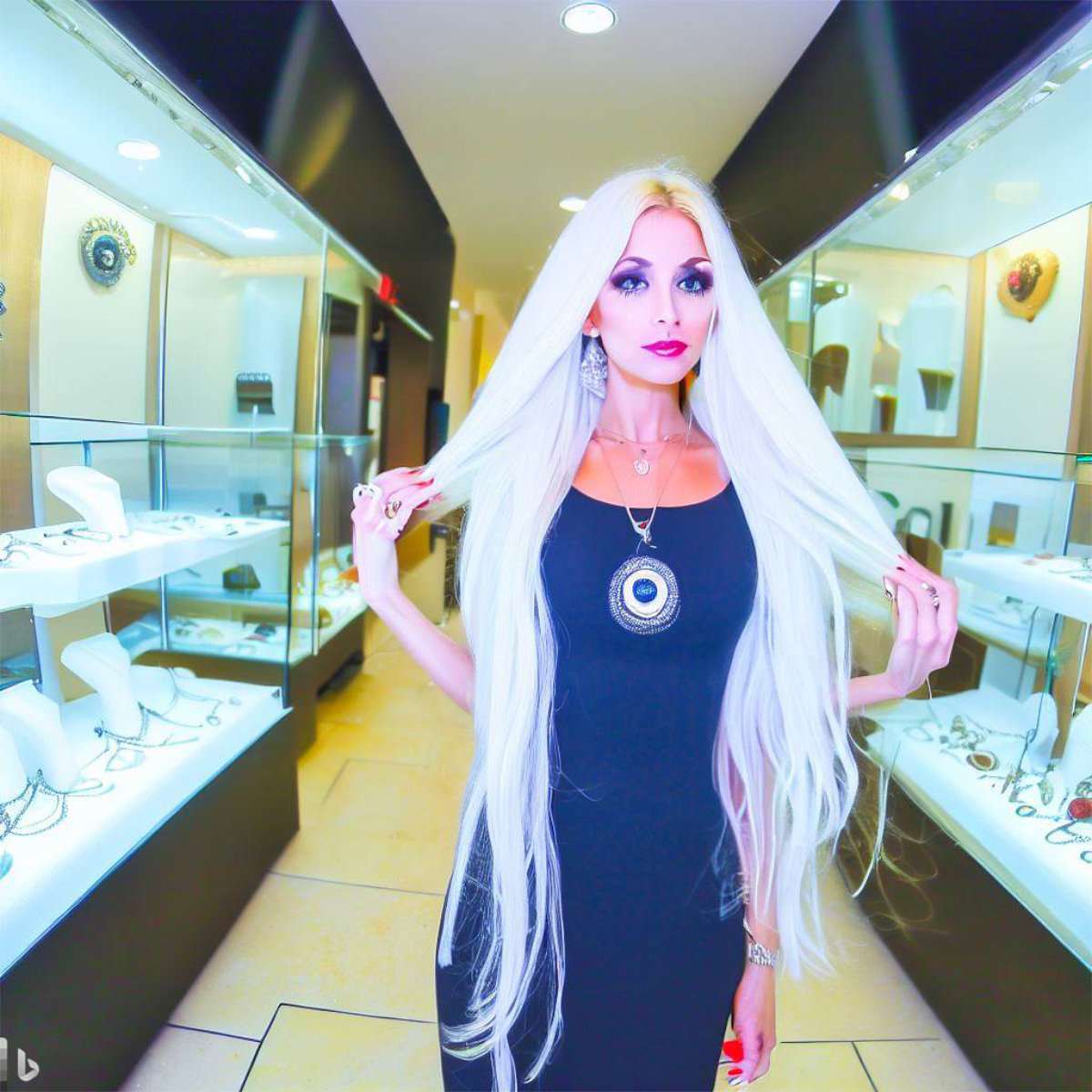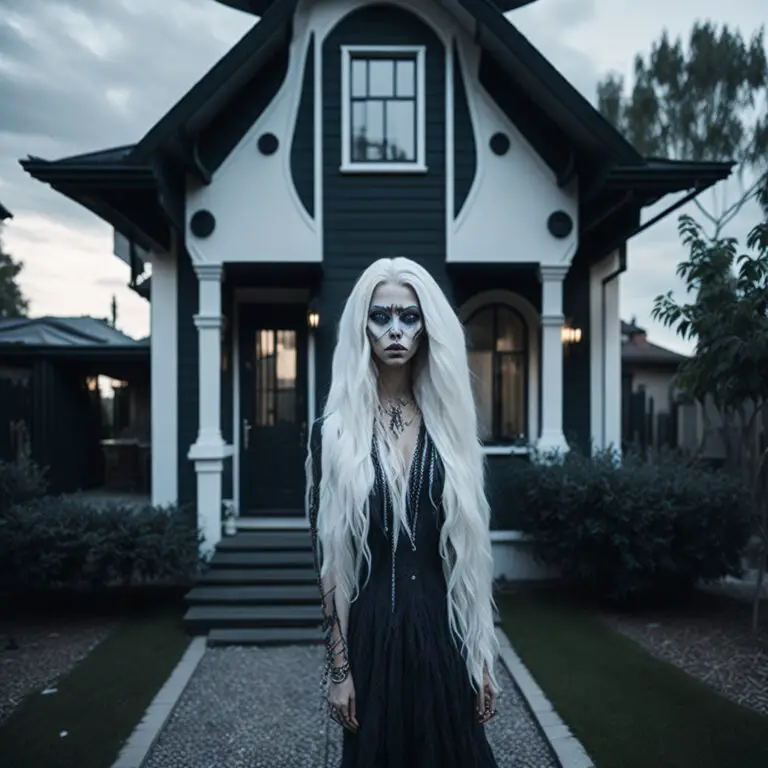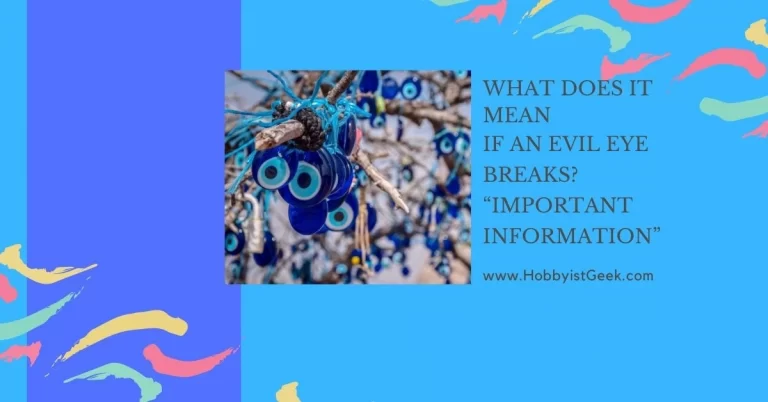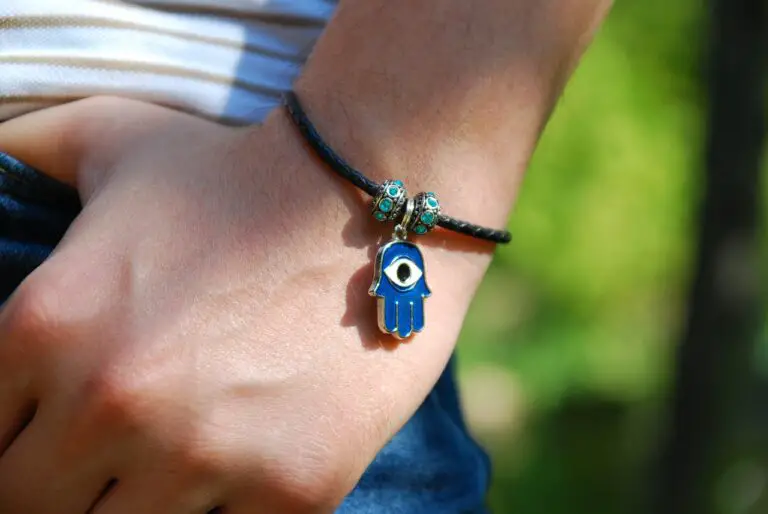Can you buy yourself an evil eye?: Important!
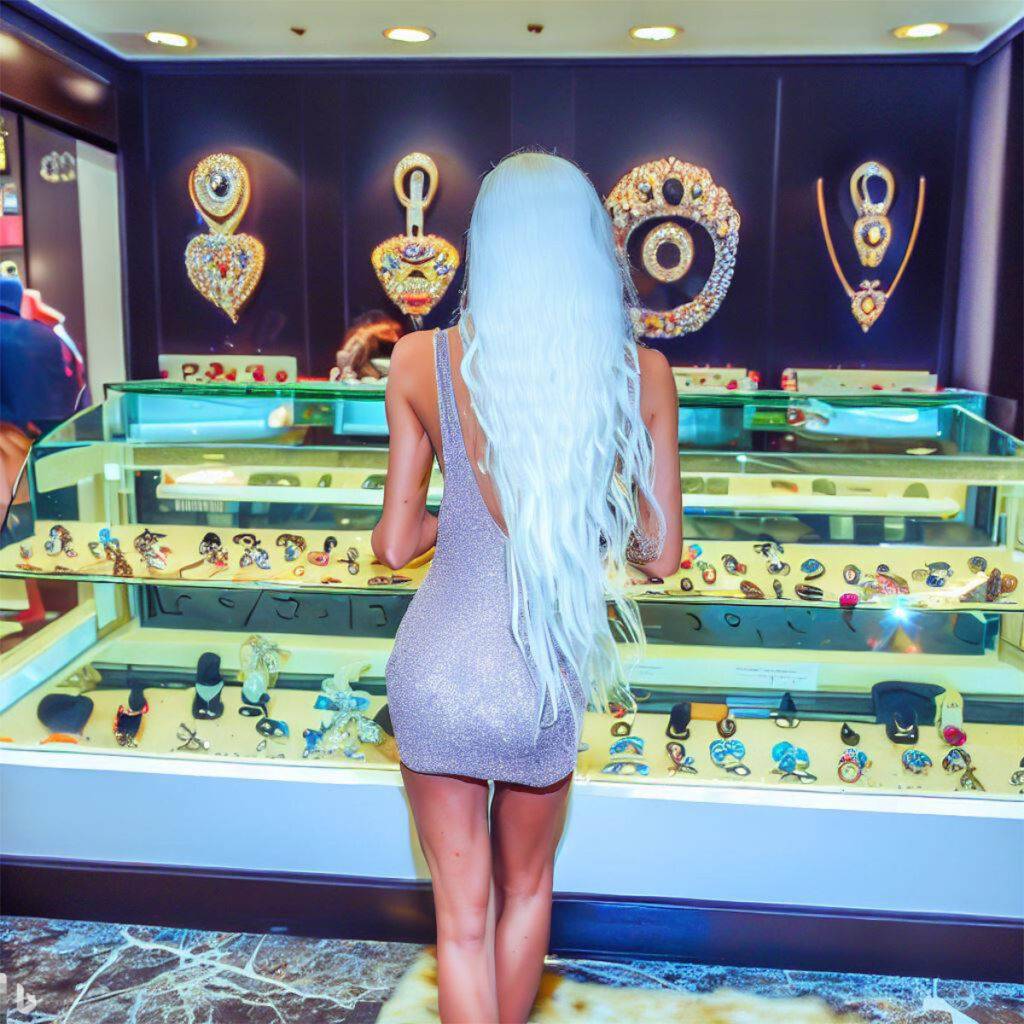
Article Takeaways
- Introduction to the Concept of the Evil Eye:
- The concept of the evil eye has intrigued and fascinated people across cultures for centuries.
- This belief in an envious gaze that brings misfortune or harm has been deeply rooted in various societies from ancient times to the modern world.
- The Evil Eye as a Protective Amulet:
- The evil eye holds different symbolic meanings and serves as a protective amulet in many cultural traditions.
- Exploring the question: Can you buy yourself an evil eye?
- Cultural Significance and Interpretations:
- Cultural significance is at the heart of understanding the evil eye phenomenon.
- Various regions have their own unique interpretations of this belief, with rituals and customs tied to its significance.
- The Evil Eye as a Powerful Talisman:
- In some cultures, it is seen as a powerful talisman that wards off negativity and offers psychological comfort to believers.
- The tradition of wearing or displaying an evil eye symbol carries deep-rooted cultural meaning and is often handed down through generations.
- Ethical Consumerism and Cultural Sensitivity:
- As interest in the evil eye expands globally, questions arise around ethical consumerism and cultural sensitivity.
- Emphasizing the importance of understanding cultural significance and respecting origins to avoid cultural appropriation.
- Reasons for Purchasing Evil Eyes:
- Exploring why people buy evil eyes, including personal beliefs, spiritual practices, fashion statements, and collecting symbolic gifts.
- Mentioning the popularity of customized charms that allow individuals to incorporate their personal beliefs while maintaining cultural understanding and respect.
Introduction to the Evil Eye
The evil eye, a concept deeply rooted in various cultures worldwide, is believed to be a powerful force that can cause harm or misfortune to those who fall under its gaze. This intriguing belief has gained attention for centuries due to its symbolic meanings and cultural significance. The idea of the evil eye revolves around the notion that some individuals possess the ability to cast a malevolent glance upon others, leading to unfortunate consequences.
Across different societies and regions, the evil eye holds varying interpretations and practices. In Mediterranean countries such as Greece, Turkey, and Italy, the belief in the evil eye runs deep.
It is commonly seen as a cultural understanding that extends beyond superstition into spiritual practices. In these societies, protection against the evil eye is highly valued, leading people to seek out protective amulets or wear evil eye jewelry as a means of warding off negative energies.
The belief in the power of the evil eye is not confined solely to Mediterranean cultures. Superstitions surrounding this concept can be found worldwide in various forms.
For instance, in parts of Africa and South Asia, there are similar beliefs about the “evil look” or “jealous gaze” causing harm or bad luck. Indigenous cultures across different continents also have their own versions of protective rituals and talisman traditions tied to warding off ill effects from an envious glance.
Understanding the cultural significance associated with the evil eye allows us to appreciate why it has become such a prevalent belief system across diverse communities. Symbolic gifts featuring an evil eye charm are often exchanged with loved ones as acts of care and protection.
This gifting tradition reflects not only personal beliefs but also serves as a means of expressing love and concern for someone’s well-being. While embracing different cultural practices can be fascinating and enlightening, it is crucial to approach them with cultural sensitivity and respect.
Cultural appropriation should always be avoided when considering incorporating symbols like the evil eye into one’s life or wardrobe. The significance of these symbols goes beyond mere fashion statements, and it is essential to recognize and honor the deep-rooted belief systems they represent.
Overall, the evil eye holds great cultural and symbolic meaning in various parts of the world. Its significance transcends superstition as it becomes intertwined with cultural practices, beliefs, and protective rituals.
Whether one chooses to wear an evil eye amulet for psychological comfort or embraces it as a symbol of personal beliefs, understanding its cultural context is vital for appreciating its true significance. By doing so, we can engage in ethical consumerism while supporting local artisans who create authentic evil eye items and contribute to preserving centuries-old traditions.
Cultural Variations of the Evil Eye!
Across different cultures and regions, the belief in the evil eye manifests in various ways. From the Mediterranean to Africa, Asia to Latin America, this intriguing concept has woven itself into the fabric of diverse societies worldwide.
Understanding how different cultures perceive and deal with the evil eye provides a fascinating glimpse into their belief systems and spiritual practices. In many Mediterranean countries, such as Greece, Turkey, and Italy, the belief in the evil eye runs deep.
It is often seen as a pervasive force that can cause harm or misfortune to individuals or their possessions. To counteract its effects, people rely on protective amulets or talismans.
These can take various forms, from blue glass beads known as “nazar” in Turkish folklore to ornate gold jewelry adorned with symbolic eye motifs. Such items are believed to ward off negativity and bring good fortune.
In Middle Eastern cultures like Egypt and Lebanon, the belief in the evil eye is also strong. However, here it goes beyond mere protection against negative energy; it is deeply ingrained in daily life and social interactions.
Families often pass down generations-old traditions that involve rituals aimed at dispelling or deflecting the evil eye’s influence. For example, newborns may be adorned with small silver amulets featuring an eye motif for protection against malevolent glances.
Across Africa, particularly in countries like Nigeria and Morocco, ancient beliefs intertwine with modern interpretations of the evil eye. In these regions too, protective charms play a significant role.
However, cultural understanding reveals that symbolic meanings associated with specific designs vary greatly between tribes and communities. For instance, among the Yoruba people of Nigeria, cowrie shells are used as potent talismans against negative energy.
In Asian cultures such as India and China, while not as pervasive as in some other regions mentioned earlier, beliefs regarding the evil eye still exist within certain communities or subcultures. In India especially, there are localized beliefs in the “nazar” or “nazrana,” similar to the concept of the evil eye.
These beliefs often influence gifting traditions, with symbolic gifts such as amulets or evil eye jewelry exchanged to provide psychological comfort and protection against negative energy. Understanding cultural variations in how the evil eye is perceived and dealt with sheds light on the rich tapestry of global superstitions, belief systems, and spiritual practices.
It highlights the significance of personal beliefs and traditions in different cultures, emphasizing how protective amulets or talismans are deeply rooted in their respective cultural identities. By appreciating these cultural nuances, we can approach the topic of buying an evil eye item with greater cultural sensitivity and a deeper understanding of its historical and symbolic importance.
Protection Against the Evil Eye!
This table provides a structured overview of the methods of protection against the evil eye, their descriptions, cultural significance, and the importance of cultural considerations when adopting these practices.
| Protection Against the Evil Eye Methods | Description | Cultural Significance |
|---|---|---|
| Amulets and Talismans | Small objects, carried or worn, are made from various materials like metal, glass, or natural elements. Incorporate symbolic meanings related to repelling malevolent forces. Customized charms are believed to be more powerful. | Reflect deeply rooted belief systems; serve as symbolic reminders of protection and sources of psychological comfort. |
| Charms | Practices that vary across cultures, involve invoking spiritual forces to counteract negative energies associated with the evil eye. May include prayers, cleansing ceremonies with herbs/incense, and meditative exercises to enhance spiritual resilience. | Hold significance in warding off negativity; customized charms are considered especially potent in providing protection. |
| Rituals | Understanding the cultural context behind these protective methods is crucial to avoiding cultural appropriation and ensure traditions are honored. Consulting with cultural experts or individuals familiar with the specific traditions is advisable for proper incorporation. | Play a significant role in protecting against the evil eye; important for those who believe in them. Should be approached with respect and cultural sensitivity to avoid appropriation. |
| Cultural Considerations | Understanding the cultural context behind these protective methods is crucial to avoiding cultural appropriation and ensuring traditions are honored. Consulting with cultural experts or individuals familiar with the specific traditions is advisable for proper incorporation. | Key to respecting and preserving cultural significance; guidance from experts helps ensure appropriate adoption of protective practices. |
Protection against the evil eye has been a significant concern for many cultures throughout history. People have developed various methods and talismans to safeguard themselves from its negative influence.
From amulets to charms and rituals, these protective practices reflect the deeply rooted belief systems and cultural significance associated with the evil eye. One common method of protection against the evil eye is the use of amulets or talismans.
These objects are believed to possess special powers that can ward off harm caused by the evil eye. Amulets come in various forms, such as pendants, bracelets, or keychains, and often feature an intricate design depicting an eye.
The evil eye jewelry serves as a symbolic reminder of protection and acts as a shield against negative energy. Many individuals wear these amulets as a personal belief in their ability to provide psychological comfort.
Charms are another popular means of protection against the evil eye. These small objects are typically carried or worn on one’s person and come in different shapes and materials, including metal, glass, or even natural elements like stones or shells.
Charms often incorporate symbolic meanings related to warding off negativity or repelling malevolent forces. Many cultures also believe that customized charms tailored specifically for an individual carry more power in protecting them from the effects of the evil eye.
Rituals play a significant role in protection against the evil eye as well. These practices may vary across different cultures but generally involve invoking spiritual forces to counteract negative energies associated with the malevolent gaze.
Rituals can include reciting prayers, performing cleansing ceremonies using specific herbs or incense, and even engaging in meditative practices aimed at strengthening one’s spiritual resilience. It is important to note that while these methods of protection hold deep cultural significance for those who believe in them, they should be approached with respect and cultural sensitivity by outsiders seeking to adopt them into their own lives.
Understanding the context behind these practices is crucial to avoid cultural appropriation and to ensure that the traditions are honored. Additionally, consulting with cultural experts or individuals familiar with the specific traditions can provide guidance on how to appropriately incorporate these protective rituals, amulets, and charms into one’s life.
Modern Interpretations of the Evil Eye!
In the modern world, the concept of the evil eye has found its place in various aspects of popular culture, fashion, and art. Superstitions worldwide have influenced contemporary interpretations of this ancient belief, leading to its incorporation into diverse mediums. From evil eye jewelry to symbolic paintings, the evil eye’s presence has permeated many avenues.
Evil Eye Jewelry stands at the forefront of modern interpretations. These accessories are not only fashionable but also carry symbolic meanings and spiritual practices within them.
From delicate pendants to intricate bracelets adorned with protective amulets, there is a wide range of designs catering to different tastes and beliefs. People choose these pieces as a talisman tradition that provides psychological comfort and a sense of cultural understanding.
Cultural appropriation surrounding the evil eye is an important consideration in modern interpretations. While some argue that embracing different cultural beliefs through customized charms is a form of appreciation, others stress the need for cultural sensitivity.
It is crucial to approach these symbols with an understanding of their cultural significance and avoid diluting or misrepresenting their meaning. Artists have also embraced the concept of the evil eye in various mediums, creating beautiful works that explore its symbolism and power.
From paintings to sculptures, these artistic expressions delve into both personal beliefs and broader societal implications associated with this age-old belief system. Such creations allow individuals to connect with and appreciate different cultures while engaging with their own spirituality.
In popular culture, references to the evil eye can be found in movies, TV shows, music videos, and even fashion trends. Celebrities often don evil eye-themed clothing or accessories as a fashion statement or as symbolic gifts given by fans or loved ones.
This integration into mainstream culture helps spread awareness about this ancient belief system while allowing individuals to express themselves through their personal style. Modern interpretations of the evil eye encompass a wide range of expressions found within popular culture, fashion trends, and art forms.
This inclusion highlights both personal beliefs and cultural understanding, as well as the importance of approaching these interpretations with sensitivity and respect. Whether through evil eye jewelry, artistic creations, or references in popular culture, the concept continues to captivate individuals seeking protection rituals or simply embracing its symbolic allure.
Personal Belief and Intentions of the Evil Eye!
The decision to buy an evil eye can be influenced by a variety of factors, including personal beliefs and intentions. People purchase these protective charms for various reasons, ranging from a genuine belief in their protective powers to using them as cultural symbols or fashion statements.
For some individuals, buying an evil eye is rooted in their deep-seated belief in the symbolism and power attributed to this ancient talisman. They see it as more than just an accessory; it provides them with psychological comfort and a sense of protection against negative energies.
Whether stemming from personal experiences or cultural traditions, these individuals find solace in the idea that wearing or displaying an evil eye can ward off the malevolent gaze of others. On the other hand, there are those who view the evil eye primarily as a cultural symbol.
They may appreciate its significance within their heritage or simply find it aesthetically appealing. These individuals may not necessarily believe in its protective powers but still embrace it as a way to connect with their roots or showcase their appreciation for different cultures.
In this case, purchasing an evil eye becomes a way of honoring its cultural significance and incorporating it into their personal style. Additionally, some people buy an evil eye purely for its fashionable appeal.
In recent years, the popularity of evil eye jewelry and accessories has soared, making them trendy additions to any outfit. This category of buyers may not prioritize the traditional beliefs associated with the charm but rather focus on how it complements their style or makes a fashion statement.
It is important to note that discussions around buying and wearing symbols like the evil eye should consider cultural sensitivity and understanding. While many people embrace these symbols without harm or ill intent, there is also potential for cultural appropriation if they are not approached respectfully.
It is crucial to be aware of the historical context and symbolic meanings behind these talismans while also respecting the communities from which they originate. Personal beliefs play a significant role in determining why someone might choose to purchase an evil eye.
Whether rooted in belief systems, cultural appreciation, or fashion preferences, individuals have various motivations when acquiring these protective amulets. Understanding the diverse reasons behind their purchase can help foster cultural understanding and ensure that these symbols are respected and valued as they have been for centuries.
Choosing the Right Symbol of the Evil Eye!
When it comes to choosing the right evil eye symbol or item, there are several factors to consider. The design, materials used and the meaning behind the symbol can all influence your choice. Understanding these variations will help you find an evil eye that resonates with you and aligns with your beliefs.
Design plays a crucial role in selecting the right evil eye symbol. There are countless designs available, ranging from traditional to modern interpretations.
Traditional designs often feature a single blue eye-shaped amulet, while modern variations may incorporate additional elements or embellishments. Consider whether you prefer a more simplistic or ornate design based on your personal taste and the cultural significance you wish to embrace.
Materials used in evil eye jewelry can also contribute to its symbolism and aesthetic appeal. The most common material is glass, which is believed to have protective properties against the evil eye due to its reflective nature.
However, you can also find evil eyes made from different gemstones such as turquoise or sapphire, each carrying its own symbolic meanings and associations with protection. Understanding the meaning behind various symbols is essential when choosing an evil eye that resonates with you.
Different cultures ascribe different meanings to specific symbols related to protection against the evil eye. For example, some cultures believe that a hand-shaped symbol (known as Hamsa) combined with an evil eye offers enhanced protection against negativity.
Researching these symbolic meanings will help ensure that your chosen item aligns with your intentions and beliefs. Ultimately, choosing the right evil eye involves a personal connection between yourself and the symbolism it holds.
Take into account your own cultural background, belief systems, and experiences when making this decision. It’s important to remember that this choice goes beyond mere fashion; it’s about finding psychological comfort through protective amulets or connecting with cultural traditions worldwide.
By considering design aesthetics, materials used in construction, and understanding symbolic meanings associated with various patterns or symbols of protection rituals worldwide – you can find an evil eye that resonates with your personal beliefs and aligns with cultural sensitivity. Remember, the choice of an evil eye is a personal one, so take your time to explore various options and find the perfect talisman that speaks to you.
Authenticity and Source of the Evil Eye!
When it comes to purchasing an evil eye item, authenticity and source play a crucial role. To ensure you are getting a genuine and culturally respectful product, it is essential to buy from reputable sources.
Avoiding counterfeit or culturally insensitive products not only guarantees the efficacy of the evil eye symbol but also demonstrates cultural sensitivity. One way to ensure authenticity is by doing thorough research on the specific symbol or item you are interested in purchasing.
Understanding the symbolic meanings and cultural significance associated with different variations of evil eye jewelry or protective amulets can help you distinguish between authentic pieces and mere imitations. Look for sources that provide detailed information about the origin and traditional use of these symbols to make an informed decision.
Another important aspect is to consider the craftsmanship and materials used in creating the evil eye item. Authentic pieces often showcase intricate designs, meticulous attention to detail, and quality materials that reflect their cultural heritage.
Reputable sources will provide information about the artisans or communities behind the production, giving you confidence in both the authenticity and ethical origins of your purchase. Avoiding culturally insensitive products is equally crucial.
Cultures worldwide have beliefs, superstitions, and spiritual practices associated with the evil eye; therefore, it is important not to appropriate or trivialize these belief systems through your purchases. Respect for cultural understanding involves being mindful of sacred traditions and avoiding items that may misrepresent or exploit a culture’s beliefs for commercial gain.
By taking these precautions when buying an evil eye item, you not only ensure its authenticity but also contribute to ethical consumerism by supporting artisans who preserve traditional craftsmanship. Your purchase becomes more than just a fashion statement; it becomes a symbol of cultural sensitivity while offering personal protection against negative energies – all aspects deeply rooted in centuries-old traditions surrounding this talismanic tradition.
Customization and Personalization of the Evil Eye!
In contemporary society, the trend of customizing or personalizing evil eye items has gained significant popularity. People seek to add their own touch to these protective symbols, making them unique and reflective of their personal style and beliefs.
The significance of customization lies in the ability to create a deeper connection with the amulet and enhance its symbolic meaning. Customization allows individuals to infuse their own personal beliefs into the evil eye symbol.
For some, it may be a way of aligning the protective power with specific intentions or desires. By adding personalized elements such as initials, birthstones, or other meaningful symbols, people can create a talisman that resonates more deeply with their individuality and aspirations.
This trend also reflects a deeper cultural understanding and appreciation for the evil eye’s significance. By customizing an evil eye item, individuals demonstrate an active engagement with the cultural traditions associated with this belief system.
It showcases a desire to delve beyond surface-level appropriation and instead embrace the rich history and symbolism that underpin this ancient talisman tradition. Psychological comfort plays a crucial role in why people choose to customize their evil eye jewelry or charms.
Personalizing these protective amulets can provide an added sense of ownership and emotional connection. When wearing or displaying customized pieces, individuals often feel a heightened sense of faith in their power, giving them peace of mind against potential harm from the envious gaze.
Furthermore, customization allows individuals to express themselves creatively through their choice of materials, colors, and designs. Some might opt for minimalist or modern interpretations while others may prefer intricate traditional patterns associated with specific cultural backgrounds.
This individual expression is not only aesthetically pleasing but also serves as a reminder of one’s unique identity within wider societal narratives. As you embark on personalizing your own evil eye item, it is essential to approach this trend with cultural sensitivity in mind.
Respectful customization involves balancing self-expression while honoring the historical context and significance behind these symbols. By doing so, you not only create a meaningful and personalized talisman but also contribute to the ethical consumerism movement by supporting artisans who specialize in crafting culturally authentic evil eye items.
Cultural Sensitivity of the Evil Eye!
When it comes to incorporating the evil eye into our lives, it’s crucial to approach it with cultural sensitivity and respect. Understanding the history and context behind this belief is essential to honor its cultural significance.
The evil eye has deep roots in various cultures worldwide, each with its own unique interpretations and practices surrounding it. To begin, take the time to educate yourself about the belief systems and cultural traditions associated with the evil eye.
Research the specific cultures that hold this belief dear, such as Mediterranean, Middle Eastern, or South Asian cultures. Learn about their folklore, superstitions, and protective amulets related to warding off the evil eye.
This knowledge will enable you to appreciate and respect the symbolism attached to these charms. Cultural understanding also involves recognizing that for some individuals, wearing evil eye jewelry or displaying evil eye symbols holds deep personal or spiritual significance.
It may provide psychological comfort or a sense of protection against negative energies. By acknowledging this aspect of personal beliefs, we can avoid dismissing or trivializing someone’s genuine connection to these symbols.
Another aspect of cultural sensitivity is being aware of potential issues related to cultural appropriation. While many people appreciate the aesthetic appeal of evil eye jewelry or charms without necessarily subscribing to its religious or spiritual connotations, it’s essential not to appropriate a culture’s beliefs for fashion purposes alone.
Respectfully engage with these symbols by understanding their origins rather than commodifying them without regard for their deeper meaning. Incorporating the evil eye into your life can be done tastefully by choosing items created by artisans who have a genuine connection to these traditions.
Seek out ethically sourced products that support local communities and preserve traditional craftsmanship. By purchasing from reputable sources that value cultural authenticity, you contribute positively while enjoying beautiful pieces imbued with symbolic meanings.
Remember that while incorporating the evil eye into your life can be an exciting way to embrace different cultures’ traditions and aesthetics, doing so requires thoughtfulness and an understanding of the belief systems surrounding it. By approaching the evil eye with cultural sensitivity and respect, you can honor its significance while enjoying its aesthetic appeal or protective qualities.
Collecting and Displaying of the Evil Eye!
When it comes to incorporating evil eye items into your home or wardrobe, there are numerous creative and tasteful ways to display and wear these powerful symbols. Whether you’re seeking cultural significance, psychological comfort, or simply a stylish accessory, there are plenty of options to consider.
When it comes to home decor, displaying evil-eye items can add a touch of mysticism and cultural richness to your space. Consider hanging evil eye wall art or placing decorative evil eye figurines on shelves or mantelpieces.
These items not only serve as protective amulets but also add a unique aesthetic element to your surroundings. Additionally, using evil eye-themed textiles such as pillows or throws can infuse your home with symbolic meaning while adding a cozy touch.
For those interested in wearing evil eye jewelry, the options are endless. Evil eye necklaces, bracelets, and earrings are widely available in various designs and materials.
You can opt for delicate pieces that incorporate the evil eye symbol discreetly into their design for a subtle yet meaningful touch. Alternatively, bold statement pieces featuring larger evil eye charms can make an impact while showcasing your personal style.
One popular trend is customizing evil eye charms or jewelry to reflect your own beliefs or preferences. Many artisans offer the option to personalize these symbols by adding initials, birthstones, or other sentimental elements.
This allows you to create a more individualized connection with the item and its protective symbolism while honoring cultural understanding. It’s important when displaying or wearing evil eye items that we practice cultural sensitivity and avoid appropriating traditions without proper knowledge.
Take the time to understand the symbolic meanings behind these objects within different belief systems and cultures worldwide. By doing so, we can ensure that our appreciation for these symbols extends beyond superficial trends and embraces their true significance.
Remember that incorporating evil eye items into our lives goes beyond fashion statements – it’s about respecting diverse cultures, protecting ourselves from negative energies (according to belief), and supporting ethical consumerism. So, whether you choose to display them as home decor or wear them as jewelry, let these symbolic gifts serve as a reminder of the rich cultural heritage they represent and the protective powers they are believed to possess.
Sharing the Symbolism of the Evil Eye!
When it comes to the evil eye, gifting protective charms to loved ones is a practice deeply rooted in cultural traditions and symbolism. The act of giving an evil eye item goes beyond just exchanging material possessions—it carries with it a powerful message of care and concern for the recipient’s well-being. Understanding the cultural significance behind this gesture can add depth and meaning to the act of sharing the symbolism of the evil eye.
In many cultures around the world, gifting traditions are intertwined with superstitions and belief systems surrounding the evil eye. These protective charms are seen as more than just accessories; they are believed to ward off negative energy and bring good fortune.
By gifting an evil eye amulet or piece of jewelry, you are conveying your desire for the recipient’s protection against malevolent forces. The symbolic significance of these gifts varies across different cultures.
In some societies, they may represent a tangible expression of love, friendship, or familial bonds. For example, in Mediterranean cultures where belief in the evil eye is strong, giving someone an evil eye charm is considered an act of genuine care and affection.
It symbolizes your wish for their well-being and safeguards them from any harm that may come their way. Moreover, presenting someone with an evil eye gift can also serve as an expression of cultural understanding and sensitivity.
By acknowledging and respecting another person’s belief system through such a gift, you are showing your appreciation for their traditions and values. This can foster deeper connections between individuals from different backgrounds while promoting cultural exchange.
It’s important to note that when gifting evil eye items, one should exercise cultural sensitivity to avoid appropriating or misrepresenting another culture’s beliefs. Take time to learn about the specific symbolic meanings associated with these gifts in different societies before giving them.
This knowledge will ensure that your gesture is respectful rather than unintentionally offensive. Sharing the symbolism behind evil eye items through gifting is a beautiful way to show care and concern for loved ones.
It reflects a desire for their protection and well-being, while also fostering cultural understanding and appreciation. So, the next time you are looking for a meaningful gift, consider the power of an evil eye charm—it’s not just a piece of jewelry but a profound expression of love and cultural significance.
Gifting Tradition of the Evil Eye!
Gifting Tradition: Explore the tradition of gifting evil eye items and the cultural significance of receiving them as gifts. Discuss the meaning of such gifts and when it is appropriate to give or receive them.
The tradition of gifting evil eye items holds immense cultural significance in many societies around the world. In these cultures, the act of giving or receiving an evil eye item goes beyond mere material exchange; it is a symbolic gesture that conveys care, protection, and good wishes to the recipient.
Understanding the cultural context behind these gifts helps us appreciate their deeper meaning. In several cultures, evil eye items are believed to ward off negative energy and protect against malevolent influences.
By gifting someone an evil eye, you are essentially offering them a shield against any potential harm or ill intentions that may come their way. This act reflects a genuine concern for their well-being and demonstrates your desire to keep them safe from harm.
The appropriateness of giving or receiving an evil eye gift can vary depending on different factors such as cultural beliefs and personal relationships. In some cultures, it is common to give evil eyes as protective amulets to newborn babies or newlyweds, symbolizing wishes for a blessed life free from negativity.
Similarly, during times of transition or important milestones in life, such as moving into a new home or starting a new job, presenting someone with an evil eye gift can be seen as a thoughtful gesture meant to bring positive energy into their new phase. It’s important to approach gifting traditions with cultural sensitivity and respect for different belief systems.
While some view these items purely as symbols of protection against negative energies, others hold deep spiritual beliefs tied to specific rituals and practices associated with the evil eye tradition. Understanding these nuances will help ensure that you engage in ethical consumerism by treating these symbols with reverence rather than reducing them to fashion accessories devoid of their symbolic meanings.
When considering giving or receiving an evil eye gift, it is crucial to be aware of the cultural significance surrounding this practice. Respect the traditions and customs associated with it, ensuring that you approach the act of gifting with sincerity and understanding.
Additionally, if you are unfamiliar with the specific cultural practices related to evil eye gifts, it might be beneficial to educate yourself and seek guidance from knowledgeable individuals or cultural experts who can provide insights about appropriate ways to engage with this tradition. By embracing cultural understanding and appreciating the symbolic importance of evil eye gifts, we can participate in these gifting traditions in a meaningful and respectful manner.
Let us remember that these gifts carry centuries-old beliefs and superstitions worldwide, connecting us to a rich tapestry of human history and belief systems. So, when you give or receive an evil eye item as a gift, cherish it not just as a beautiful adornment but also as a symbol of protection and goodwill from the giver.
Buying as a Gesture of Care for the Evil Eye!
Buying an evil eye for someone can be a beautiful gesture that reflects care and concern for their well-being. In many cultures where the evil eye belief is deeply ingrained, this act of gifting a protective charm holds significant meaning. The evil eye symbolizes protection against negative energies and ill intentions, making it a thoughtful present to someone you hold dear.
In some cultures, the evil eye is believed to possess strong protective powers and ward off harm. By buying an evil eye for someone, you are essentially expressing your desire to shield them from any potential harm or misfortune.
This act shows that you genuinely care about their safety and well-being. It’s a symbolic gift that carries both practical and emotional value.
Psychologically, giving an evil eye as a gift can also provide comfort. Knowing that someone cares enough to bestow upon you a potent symbol of protection can instill a sense of security and reassurance in the recipient.
It serves as a reminder that they are not alone in facing life’s challenges; they have someone looking out for them. Moreover, gifting an evil eye showcases your understanding and respect for cultural beliefs and traditions associated with this symbol.
By acknowledging its cultural significance, you demonstrate cultural sensitivity by honoring the belief systems of others. This shows your willingness to embrace diversity and appreciate different perspectives.
While buying an evil eye as a gesture of care is meaningful in cultures where it holds deep-rooted beliefs, it’s essential to approach this act with sincerity and respect rather than merely adopting it as a passing trend or fashion statement. Understanding the symbolic meanings behind this symbol will help ensure your gift truly resonates with its intended purpose.
Ultimately, buying an evil eye for someone demonstrates your thoughtfulness towards their well-being while embracing the rich cultural significance attached to this ancient talisman tradition worldwide. By considering both practical protection rituals associated with the charm itself and respecting diverse belief systems, you can give a gift that carries profound meaning and shows genuine care for the recipient’s safety and happiness.
Customs and Rituals of the Evil Eye!
Customs and Rituals: Exploring any customs or rituals associated with the purchase and gifting of evil eye items unveils a fascinating tapestry of cultural practices and beliefs. The decision to buy or gift an evil eye symbol is often influenced by these deeply ingrained traditions.
In various cultures around the world, the purchasing process goes beyond a mere transaction; it is steeped in symbolic meanings and protective rituals. One such tradition can be found in Greek culture, where the Evil Eye Belief runs deep.
When buying an evil eye charm, it is common for individuals to visit local artisans or specialized shops that have been creating these customized charms for generations. This cultural understanding is important as it ensures that they are supporting local craftsmanship while also receiving authentic pieces imbued with symbolic significance.
The process becomes more than simply acquiring a trinket; it becomes an act of ethical consumerism intertwined with spiritual practices. The decision-making process regarding the purchase or gift of evil eye items can also be influenced by personal beliefs and protective amulet traditions.
For example, in some Middle Eastern cultures, pregnant women are often gifted evil eye jewelry as a means of protection for themselves and their unborn children. This belief stems from centuries-old talisman tradition where the evil eye symbol wards off ill-intentions and wards off bad energy.
In addition to personal beliefs, several protection rituals are associated with the acquisition of evil eye symbols. In Turkey, one common ritual involves hanging blue glass beads known as nazar boncuk on doorways or in cars to ward off the evil eye’s gaze.
These acts serve not only as visual reminders but also provide psychological comfort amidst superstitions worldwide. It’s important to approach these customs and rituals from diverse cultural backgrounds with cultural sensitivity—acknowledging their significance without appropriating their beliefs.
Understanding how various belief systems intertwine with symbolic meanings allows individuals to appreciate the rich tapestry of human culture while making informed decisions. The customs and rituals associated with the purchase and gifting of evil eye items not only add depth and meaning to the process but also foster a connection to centuries-old traditions that continue to thrive in our modern world.
Consulting Cultural Experts of the Evil Eye!
When it comes to buying an evil eye, consulting cultural experts or individuals knowledgeable about its significance can greatly enhance your understanding of this ancient symbol. Seeking insights from those with cultural expertise offers several benefits that can help inform your decision.
First and foremost, consulting cultural experts ensures that you approach the purchase of an evil eye with a sense of cultural understanding and sensitivity. These experts can provide you with valuable information about the history, beliefs, and customs associated with the evil eye in different cultures.
By gaining insights into its symbolic meanings and cultural significance, you can make a more informed decision about whether or not to buy one for yourself. Additionally, consulting cultural experts helps you navigate the complexities of ethical consumerism.
In a world where cultural appropriation is a concern, it’s important to understand how buying an evil eye may impact the communities and artisans involved in its production. Cultural experts can guide you toward supporting local artisans who create authentic evil eye items using traditional craftsmanship.
This way, you contribute to preserving their traditions while appreciating the symbolism of the evil eye. Moreover, engaging in conversations with cultural experts allows for a deeper exploration of personal beliefs and belief systems surrounding the evil eye.
They can shed light on various superstitions worldwide related to this symbol and explain how different cultures approach protection rituals or incorporate spiritual practices involving the evil eye. Understanding these perspectives provides psychological comfort through knowledge and helps you make an informed decision rooted in personal introspection.
Consulting cultural experts opens up opportunities for customization and personalized choices when selecting an evil eye item. They can guide you on choosing designs or materials that align with specific cultures’ preferences while respecting their symbolism.
This ensures that your purchase reflects both your personal taste and appreciation for diverse cultures rather than perpetuating a generic interpretation of this powerful talisman. Consulting cultural experts before purchasing an evil eye brings numerous advantages.
It allows for meaningful engagement with different belief systems, promotes ethical consumerism by supporting local artisans, and ensures cultural sensitivity and understanding. By seeking their insights, you can make an informed decision that resonates with your personal beliefs while appreciating the rich symbolism and significance embedded in the evil eye.
Personal Connection of the Evil Eye!
Encouraging a Personal Connection When it comes to buying or receiving an evil eye, it’s important for individuals to reflect on their personal connection to this concept.
The decision to bring the evil eye into one’s life is often influenced by a variety of factors, including personal beliefs and experiences. Exploring these connections can deepen our understanding of why we feel drawn to this protective symbol.
For many individuals, their decision to buy or receive an evil eye is rooted in their personal beliefs. Whether they adhere to specific superstitions or have spiritual practices that incorporate the evil eye, these beliefs play a significant role in shaping their connection to this symbol.
Some may view it as a powerful talisman with specific symbolic meanings, while others might see it as representing cultural significance and tradition. Cultural sensitivity also comes into play when considering the personal connection one has with the evil eye.
Understanding the cultural background and significance of this symbol can greatly influence the decision-making process. It allows individuals to approach buying or receiving an evil eye with respect for its origins and meanings within various cultures worldwide.
Beyond belief systems and cultural understanding, there is also a psychological comfort that can be derived from owning an evil eye. Many people find solace in having a physical object that serves as a protective amulet against negative energy and ill intentions.
This sense of security can be especially comforting during times of uncertainty or vulnerability. Moreover, personal experiences may shape an individual’s connection to the evil eye as well.
Whether they have encountered situations where they felt someone’s envy or experienced misfortune that seemed unexplainable, these encounters can make the concept of protecting oneself from the evil eye more tangible and relatable. Reflecting on our personal connections helps us understand why we feel compelled to buy or receive an evil eye as a gift.
From deeply held beliefs and cultural appreciation to finding psychological comfort and drawing from personal experiences, these factors intertwine in shaping our relationship with this symbol. By exploring these connections, we can make more informed choices while honoring the cultural significance and traditions associated with the evil eye.
Cultural Education of the Evil Eye!
When it comes to buying or receiving an evil eye, it is essential to approach the topic with cultural education and sensitivity. Understanding the cultural context behind the evil eye will not only enhance your appreciation for its symbolic meanings but also ensure that you engage with this tradition in a respectful manner.
Cultural understanding plays a crucial role in appreciating the significance of the evil eye across different societies. By delving into various cultures’ belief systems, superstitions worldwide, and protective rituals, you can gain insight into why this symbol holds such importance for many people.
Researching the evil eye symbolism and its historical context can help you develop a deeper appreciation for its cultural significance. To further expand your cultural education on the subject, there are several resources available.
Books on talisman traditions and protective amulets can provide valuable information about the origins of the evil eye belief and its variations across cultures. Online platforms also offer numerous articles and documentaries exploring different aspects of this phenomenon.
Exploring these resources will allow you to learn about specific cultural practices associated with the evil eye and gain a broader perspective on its significance. Furthermore, engaging in conversations with individuals who have personal beliefs or experiences related to the evil eye can be enlightening.
Hearing their stories firsthand can provide unique insights into how this symbol impacts their lives and why it holds such profound meaning for them. Speaking to people from diverse cultural backgrounds will deepen your understanding of their perspectives on this topic.
When seeking cultural education about the evil eye, it is important to be mindful of ethical consumerism and cultural appropriation concerns. Ensure that any resources or sources you engage with are respectful towards various cultures’ beliefs rather than exploiting or misrepresenting them for profit.
By approaching your educational journey with sensitivity, you can foster greater respect for different traditions while expanding your knowledge about this fascinating symbol. Investing time in understanding the cultural context of the evil eye is crucial when buying or receiving such symbols.
Cultural education not only enriches your knowledge about the beliefs and rituals associated with the evil eye but also helps foster cultural sensitivity and respect. By exploring resources, engaging in conversations, and being mindful of ethical considerations, you can deepen your appreciation for this ancient tradition while approaching it with the respect it deserves.
Supporting Local Artisans of the Evil Eye!
When it comes to buying an authentic evil eye, one option that not only ensures the quality but also supports local artisans is seeking out these unique pieces from those who craft them with passion and expertise. By purchasing evil eye items directly from local artisans, you not only acquire a symbol of protection but also contribute to the preservation of traditional craftsmanship.
It’s a win-win situation that allows you to connect with the cultural significance of this ancient symbol while supporting local economies. Buying from local artisans adds a layer of authenticity to your evil eye purchase.
These skilled craftsmen and women have honed their skills through years of practice and carry the knowledge passed down through generations. Their mastery in intricately creating evil eye charms, amulets, or jewelry ensures that you are getting a piece that truly captures the essence of this symbolic talisman.
By purchasing from them, you become part of their story and help keep their craft alive. Supporting local artisans also has a positive impact on communities where the tradition of creating evil eyes is deeply rooted.
These artisans often work within close-knit communities where crafting these protective symbols is not just a profession but also an integral part of their cultural identity. By investing in their work, you contribute to the sustainability and continuation of these traditions, allowing future generations to appreciate and benefit from this rich heritage.
Ethical consumerism plays a significant role in supporting local artisans as well. By opting for authentic evil eye items made by skilled craftspeople instead of mass-produced replicas offered by commercial retailers, you can ensure fair wages and better working conditions for these artists.
This conscious choice promotes fair trade practices and empowers marginalized communities who rely on traditional craftsmanship as a means of livelihood. Overall, buying authentic evil eyes from local artisans serves multiple purposes: preserving cultural traditions, supporting economies at grassroots levels, ensuring ethical practices, and acquiring genuinely crafted symbols imbued with centuries-old meanings.
It’s an opportunity not only to protect yourself or others from the malevolent gaze but also to contribute actively to the preservation and appreciation of cultural heritage. So, next time you consider purchasing an evil eye item, take a moment to explore local artisans in your area or search for reputable online platforms that connect you with these skilled individuals who keep the flame of tradition burning bright.
Spiritual Guidance of the Evil Eye!
When it comes to matters of spirituality and belief systems, seeking guidance from religious leaders or practitioners can offer valuable insights. This holds true for those considering the purchase or gift of an evil eye symbol.
Consulting with a spiritual advisor can help provide a deeper understanding of the cultural significance and symbolism surrounding the evil eye, as well as offer guidance on how to approach it respectfully within one’s own belief system. Religious leaders and practitioners familiar with the traditions and beliefs associated with the evil eye can provide context and clarity.
They may explain various protection rituals or talisman traditions tied to the evil eye. Understanding these practices can help individuals make informed decisions about purchasing or gifting protective amulets.
In addition, seeking spiritual guidance regarding the evil eye allows for a more nuanced understanding of its cultural significance. It helps one navigate potential pitfalls related to cultural appropriation by promoting cultural sensitivity and respect.
Spiritual advisors can shed light on specific customs or beliefs attached to the evil eye in different cultures, encouraging individuals to approach it with appropriate knowledge and appreciation. Furthermore, consulting with religious leaders or practitioners offers psychological comfort for those who genuinely believe in the power of symbols like the evil eye.
By discussing personal beliefs and experiences related to this protective charm, individuals can gain a sense of validation from someone who shares their faith or spirituality. Overall, seeking spiritual guidance when considering purchasing or gifting an evil eye symbol adds another layer of depth to one’s experience.
It enhances cultural understanding while also providing an opportunity for personal growth within individual belief systems. Consulting with religious leaders or practitioners ensures that individuals approach this symbolic tradition respectfully and responsibly while honoring its rich history across various cultures globally.
Conclusion
22. Conclusion The decision to buy yourself an evil eye is a personal one that involves a blend of cultural significance, personal beliefs, and individual preferences.
The evil eye holds immense cultural value in many societies worldwide, with various interpretations and protective rituals associated with it. As we navigate through an era of global connectivity and multicultural influences, it becomes crucial to approach the buying and gifting of evil eye items with cultural sensitivity and understanding.
Ethical consumerism plays a significant role in this decision-making process. By ensuring the authenticity of the evil eye item you purchase and supporting local artisans who have mastered the craft of creating these protective talismans, you can contribute to preserving traditional cultural practices.
This not only helps sustain their livelihoods but also ensures that you are purchasing products that carry genuine symbolic meanings. Understanding the symbolism behind the evil eye is essential when customizing or personalizing your own charms.
By learning about different designs, materials used, and their significance within specific cultures, you can create meaningful pieces that respect tradition while reflecting your own personality. It is vital to remember that belief systems surrounding the evil eye differ from culture to culture.
Considering this diversity allows for a deeper appreciation of its power as well as respectful engagement with its symbolism. Consulting cultural experts or individuals knowledgeable about its significance can offer valuable insight into making informed choices.
When gifting an evil eye item or receiving one as a gift from others, it’s important to acknowledge its cultural context and understand the significance behind such gestures. Symbolic gifts like these demonstrate care for someone’s well-being while paying homage to tradition.
In today’s interconnected world, where cultures often blend together seamlessly, it becomes even more crucial to approach practices such as buying an evil eye with respect and sensitivity. Cultural appropriation should be avoided at all costs by appreciating rather than appropriating cultural symbols.
Ultimately, whether you choose to buy yourself an evil eye for spiritual comfort or simply as a fashion statement, being informed and culturally aware enriches the experience. By understanding the cultural significance, embracing personal beliefs, and engaging in ethical consumerism, you can approach this decision with mindfulness and appreciation for the traditions that have shaped it.
Remember, the power of the evil eye lies not only in its ability to protect but also in its ability to bridge cultures and foster cultural understanding. So whether you choose to wear an evil eye necklace or display an amulet at home, let it be a constant reminder of the beauty found within diverse belief systems and our shared human connection.
Another great article Evil Eye | Feng Shui For Your Home: 14 Tips For Your Protection!
Frequently Asked Questions
s it bad luck to buy my own evil eye bracelet?
There are mixed beliefs – some say yes, others believe self-purchase is fine.
What is the proper way to activate an evil eye charm?
Activation rituals vary but may involve cleansing, prayers, or wearing specific colors.
How often should I cleanse my evil eye necklace?
It’s recommended to cleanse at least monthly by rinsing in saltwater or leaving in the moonlight.
Can I wear more than one evil eye ring at a time?
Yes, wearing multiple evil eye charms is common and believed to enhance protection.
What is the meaning behind the different evil eye colors?
Blue repels negativity, green enhances luck, red boosts vitality, and black absorbs envy
- Evil Eye Hand: Unveiling the Mystical Origins and Meanings - February 2, 2024
- Amegreen Amethyst Meaning: Discover the Hidden Magic! - February 2, 2024
- Is The Evil Eye Bad?: A Deep Dive into Evil Eye Taboos - February 2, 2024

